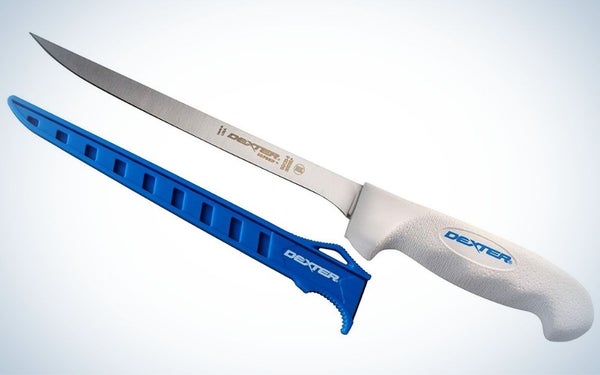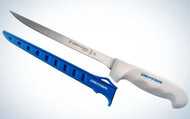Anglers need a fillet knife they can trust to help process their hard-earned catch. No one wants to tear their fresh fillets to shreds, and there’s no surer way to do so than going at them with an inferior blade. The best fillet knives need to be durable, flexible, provide plenty of grip, and be easy to sharpen. These characteristics aren’t just a recommendation, they are a necessity for getting the best fillets possible.
As outdoorsmen and women, we spend far too much time, energy, and money on our pursuits to settle for subpar gear. Thankfully, there are plenty of great manual and electric fillet knives to choose from, regardless of how many or what kind of fish you’re working with. I process and cook a lot of fish throughout the course of a year and have found that having the right fillet knives makes all the difference in the world. Here’s a short list of some of the best fillet knives on the market for a variety of users.
- Best for the Money: Dexter Outdoors SOFGRIP 8″ Flexible Fillet Knife with Edge Guard
- Best for Beginners: BUBBA 7″ Tapered Flex
- Best Budget: Rapala Fish ’n Fillet
- Best Japanese Style: Shun Classic Boning & Fillet
- Best Electric: Rapala R12 Heavy-Duty Lithium Fillet Knife Combo

A sharp and sturdy fillet knife will make your job on the cutting board much easier. Cosmo Genova
Things to Consider Before Buying a Fillet Knife
Length
The length of a fillet knife is one of its most important features. It contributes to how much control you have over the blade while cutting. A shorter blade provides accuracy in the fine, detailed cuts since there is a shorter distance between the tip of the blade and your wrist. However, it’s less ideal for long strokes. A shorter blade is also often more rigid, giving you the ability to exert more energy into a cut. A longer blade, on the other hand, provides greater reach and is often more flexible. The longer reach also makes it easier to work on larger fish and cut in places where you can’t get your hand comfortably.
Here are the most common blade lengths and where they excel:
- 6-inch Blade: A short, 6-inch blade is generally used for small to medium fish and offers control and cutting precision. This size is also useful when you need to do delicate work around big bones on large fish.
- 7-inch Blade: This do-it all blade length works great on most fish.
- 8 to 9+ inch Blade: A blade eight inches or longer offers greater reach and structural integrity for filleting and breaking down large freshwater and saltwater fish.
Flex and Thickness
The amount of flex and thickness of a blade will affect its performance dramatically. A thin, flexible blade glides across and around bones and cartilage far better than a rigid blade, while a rigid blade is better at cutting through. A flexible blade bends with the natural contours of the fish, leading to a cleaner job and less meat loss. A thick, rigid blade has a more robust profile, allowing you to exert more pressure and power into a cut, but is less malleable and forgiving. Knowing how these different factors change the performance of a knife will help you pick the best fillet knife for your needs.
Here are three rough categories that most manual fillet knife blades fall into, and how they perform.
- Stiff and Thick: Best for deboning, removing loins, and cutting fillets into serving size. Slight flexibility at the tip of the knife. Also good for cutting through and around large bones and cartilage, and for making precision cuts and trimming.
- Medium Flex and Thickness: Compromise between power and flexibility. Versatile for most types of fish. Flex point closer to the middle of the knife.
- Flexible and Thin: Best for filleting and skinning. Bends with the natural contours of the fish, gliding over bones and minimizing wasted meat. Less able to exert power into the knife. Flex point closer to the middle or base of the blade.

Volume
The amount and type of fish you expect to process is worth considering when choosing the best fillet knife for your needs. A commercial fisherman in Alaska is going to have different requirements than an ice fisherman in Michigan. If you only fish a few times per year on local water, a traditional 7-inch fillet knife might be all you need. If all you do is fish, and travel a lot to do it, one knife length and style isn’t going to cut it. If you routinely find yourself cleaning hundreds of crappie and walleye a year, you may want to think about getting an electric fillet knife.
Portability
The overall size, weight, and profile of a fillet knife is something to consider based on the type of fishing you do the most. A lightweight option that comes with a sheath or scabbard might be the best fillet knife for beginners and anglers who travel a lot to fish. Whereas an electric or a high-quality fillet knife is better suited for high volume home use. The availability of power near the places you fish may also determine whether a corded or battery-powered option is the best electric fillet knife for your needs.
Price
You don’t need to spend a fortune to get your hands on an awesome fillet knife. Even the best fillet knives are not terribly expensive. But there are premium options out there that will come at a higher price. Most fillet knives on the market are well under a hundred dollars, with some of the best electric fillet knives costing a bit more.
Best for the Money: Dexter Outdoors SOFGRIP 8″ Flexible Fillet Knife with Edge Guard

Why It Made the Cut: A USA-made workhorse that has everything you need, and nothing you don’t. It has a high-quality blade, a comfortable and non-slip grip, and is affordable.
Key Features
- DEXSTEEL blade with edge guard
- Medium flex
- SOFGRIP handle
- USA made
Pros
- Sharp and easy to sharpen
- Ergonomic, non-slip handle
- Comes with a plastic sheath
- Affordable
Cons
- No belt loop or tab on sheath
The Dexter Outdoors SOFGRIP Flexible Fillet Knife is the best fillet knife for the money. It’s perfect for beginners and seasoned veterans alike. It’s a traditional, no-frills fillet knife design. The blade has a good amount of flex to glide over bones. It’s super sharp out of the package due to the high alloy, stain resistant DEXSTEEL. The high carbon blade makes it very easy to quickly sharpen and hone compared to a harder steeled knife, so you’re not spending all day fighting to put an edge on it. Both the 7” and 8″ models are great sizes to handle most fish.
The SOFGRIP handle is soft and comfortable in the hand. It is far more slip-resistant than a wooden handled knife. It provides excellent grip even when wet and covered in fish slime. The knife hosts a smooth, sleek design that cleans up easily without a lot of seams or ridges for gunk to get trapped in. It is NSF certified making it a great option for commercial fishermen, guides, and professional cooks. It is also made in the U.S.A. and comes with a blade protector sheath that makes storage and transport much safer for both you and the blade.

